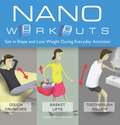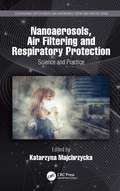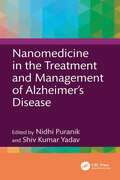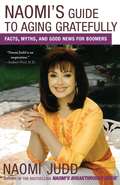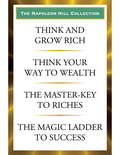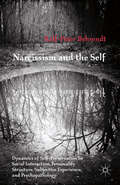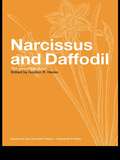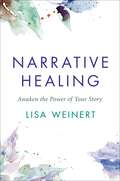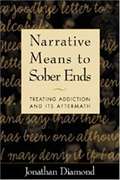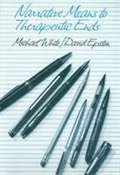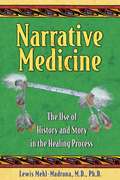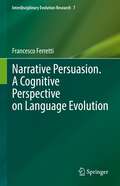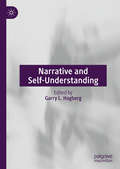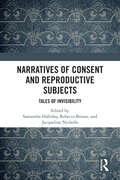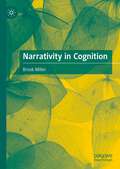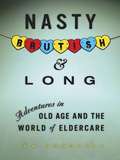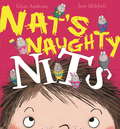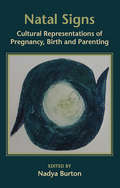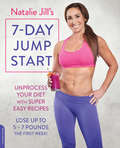- Table View
- List View
Nano Workouts: Get in Shape and Lose Weight During Everyday Activities
by Joakim ChristofferssonWORKOUT ANYTIME ANYWHEREFollow the clever and fun approach to exercise in this book and you'll discover how everyday activities can quickly and easily be transformed into workout opportunities. Turn all idle moments in life into exercise opportunities, such as:* Bathroom* Living room* Kitchen* Shopping* On the phone* Office* BedroomThere's no need to go to the gym if the time you dedicate to brushing your teeth and riding the bus is also spent building muscle and burning fat. The wide range of exercises in this book works every part of the body, and when done here and there throughout your day produce a toned, healthy physique.
Nanoaerosols, Air Filtering and Respiratory Protection: Science and Practice (Occupational Safety, Health, and Ergonomics)
by Katarzyna MajchrzyckaRecent toxicological studies show that nanoparticles released in technological processes and combustion processes outside industry can be dangerous for humans especially when entering the body through the mouth and nose. In connection with the above, the use of adequately effective respiratory protection equipment is of great importance in prophylactic and preventive activities. The first part of Nanoaerosols, Air Filtering and Respiratory Protection: Science and Practice refers to the general phenomena of filtration described on the basis of the authors’ own experience and international reports. The book also includes a description of the respiratory system and principles of its functioning and the accumulation of aerosol particles. It goes on to discuss technological innovations regarding the production of filtering materials for protection against nanoparticles and the latest test methods. Finally, the book contains information about the proper selection and use of respiratory protective devices against airborne nanoparticles in the workplace and everyday life. Special attention is paid to proper fit procedures as well as use and maintenance activities of such devices. The content of the book with rich illustrative material has been presented so that it can be used by health and safety experts, students as well as employers, employees and private users of respiratory protective devices. "Through a comprehensive approach to the subject of the work, the authors present theoretical foundations as well as practical solutions that are used in the research and development of personal respiratory protection. The complementarity of the information contained in the book will allow the reader to become familiar with a wide range of knowledge related to the design and manufacture as well as assessment of properties and procedures for the use of respiratory protection against the adverse effects of aerosols, including air contaminated with nanoparticles and microparticles. In my opinion the book is a valuable part of the series Occupational Safety, Health, and Ergonomics: Theory and Practice, published by Taylor & Francis." —Maciej Boguń, ŁUKASIEWICZ – The Textile Research Institute, Łódź
Nanomedicine in the Treatment and Management of Alzheimer's Disease
by Nidhi Puranik Shiv Kumar YadavThis book aims to discuss the various drug delivery approaches of neuroprotective medicines via nanoparticles, such as enzymes, monoclonal antibodies, neurotrophic factors, pharmaceutical drugs, and nucleic acid-based medication, to manage Alzheimer's disease.Nanomedicine in the Treatment and Management of Alzheimer's Disease investigates drug administration approaches, either separately or in combination, to improve neuroprotection in Alzheimer's disease. The book examines various novel therapeutic applications of nanomaterials in drug delivery for the central nervous system in Alzheimer's disease treatment. The book explores the role of nanoparticles in crossing the blood–brain barrier and blood-CSF barrier in the treatment and management of Alzheimer's disease. The authors also explain the nanoparticle-based delivery of therapeutic molecules including phytochemicals, peptides, siRNA, enzymes, and monoclonal antibodies in the treatment of Alzheimer's disease. Finally, the book also discusses the various challenges and future perspectives of nanomedicine in the management of Alzheimer’s disease.The book will help in bridging the gap of knowledge in neurosciences, neurotherapeutics, nanotechnology, and nanomedicine domains. The book chapter may be useful to educators, researchers, legislators, and medical professionals including pharmacologists, biochemists, corporate pharma R&D researchers, neurologists, and scientists involved in neurodegenerative diseases and nanomedicine.
Naomi's Guide to Aging Gratefully
by Naomi JuddNaomi Judd has been called "The Face of the Boomer Generation." At 78 million strong, boomers have become America's largest demographic. In Naomi's Guide to Aging Gratefully, she debunks society's harmful myths about aging and finds more meaningful ways we can define ourselves so we can enjoy (rather than dread) getting older. Freedom is the focus, and there's no better time than now to free yourself from untrue and outdated ideas about your own potential. Naomi is full of fresh ideas to help readers look at their futures in a whole new way. The aging process, as Naomi shows, is an opportunity for new experiences, original routines, and more contentment than ever before. Naomi offers tips on finding simplicity, streamlining possessions, disengaging from "energy vampires," and discovering the most effective ways to support your life force and boost your energy. Each chapter includes vital new health information and proactive lifestyle suggestions for your body, mind, and spirit. Naomi has a solution-oriented approach to everything from beauty tips to getting in sync hormonally with bioidentical HRT. She also offers wisdom on dealing with grief as well as enlightening ideas on how to recognize and enjoy your own uniqueness no matter how old you are. Packed with personal anecdotes, commentary from celebrity friends and data from renowned doctors, and plenty of Naomi's own special brand of lemonade-out-of-lemons wit and wisdom, Naomi's Guide to Aging Gratefully encourages readers to believe that it's never too early or too late to enter an important new chapter in their lives and embrace opportunities to become their happiest ever.
Napoleon Hill Collection
by Napoleon HillStart down your path to prosperity the right way--four essential books on wealth and self-improvement by Napoleon Hill for only $36.99! Napoleon Hill is considered by many to be the first and most important name in self-help and prosperity. Now, for the first time in one e-bundle, Tarcher/Penguin offers you his most important works on how to be the best you can be in one place, for one low price! Think and Grow Rich This book has been called the "Granddaddy of All Motivational Literature." It was the first book to boldly ask, "What makes a winner?" The man who asked and listened for the answer, Napoleon Hill, is now counted in the top ranks of the world's winners himself. The most famous of all teachers of success spent "a fortune and the better part of a lifetime of effort to produce the "Law of Success" philosophy that forms the basis of his books, and which is so powerfully summarized in this one. In the original Think and Grow Rich, published in 1937, Hill draws on the life stories of Andrew Carnegie, Thomas Edison, Henry Ford, and other millionaires of his generation to illustrate his principles. In the updated version, Arthur R. Pell, Ph.D., a nationally known author, lecturer, consultant in human resources management, and an expert in applying Hill's thought, deftly interweaves anecdotes of how contemporary millionaires and billionaires--such as Bill Gates, Mary Kay Ash, Dave Thomas, and Sir John Templeton--achieved their wealth. Outmoded or arcane terminology and examples are faithfully refreshed to preclude any stumbling blocks to a new generation of readers. Think Your Way to Wealth Returned to print after many years of unavailability, this book will open the doorway to a treasury of wisdom. Think Your Way to Wealth captures Napoleon Hill's initial encounter with Andrew Carnegie, who revealed the money-attracting strategy that Hill later popularized in classic books like Think and Grow Rich and The Law of Success. While working as a reporter for an inspirational magazine in 1908, Napoleon Hill chanced upon an opportunity that gave direction to his life. The young writer landed an interview with industrial giant Carnegie. Hill had just one key question for the magnate: What is the secret to your success? Carnegie's response electrified Hill and launched him on a lifelong mission to distill the steps to success into a clear, definite protocol that could be used by any motivated man or woman. Think Your Way to Wealth is Hill's vivid account of that seminal meeting. It captures Carnegie's initial advice, how-to's, practical steps, and concrete directions--all of which formed the basis for Hill's groundbreaking books and jumpstarted the field of business motivation. Originally published in 1948, Think Your Way to Wealth has been out of print and unavailable for many years. This new Tarcher Success Classics edition reproduces the complete, original text just as Hill first presented it. The dialogue between Hill and Carnegie represents an invaluable, irreplaceable playbook of success strategies that can change the life of any reader, just as they changed Hill's life that day. The Master Key to Riches The Master-Key to Riches is the blueprint that Napoleon Hill placed in the hands of those who would teach and perfect his success methods. Now revised and updated for the twenty-first century to avoid arcane language or points of reference, this book contains the full range of ideas and exercises that appeared in the original edition. In this volume, Hill covers lessons including: * The Law of Cosmic Habitforce * Andrew Carnegie's "Master Mind" Method * The Magic of Going the "Extra Mile" * The Twelve True Riches of Life The Magic Ladder to Success This book is the volume in which Napoleon Hill first distilled the seventeen factors that make up his "Law of Success" philosophy. These key principles capture the ethics and actions that empower all who harness them to become leaders in the field of their choice. Leaders are not born, Hill argues, they are molded by a remarkably similar, simple, and dynamic se...
Nappy Hair
by Carolivia HerronIn a unique and vibrant book that uses the African-American call-and-response tradition, a family talks back and forth about adorable Brenda's hair--it's the nappiest, the curliest, the twistiest hair in the whole family. The family delights in poking gentle fun with their hilarious descriptions, all the time discovering the beauty and meaning of Brenda's hair. Soulful, funny, full of rhythm, and bursting with family pride.
Narcissism and the Self: Dynamics of Self-Preservation in Social Interaction, Personality Structure, Subjective Experience, and Psychopathology
by R. BehrendtThe book examines how coevolved intraspecific aggression and appeasement gestures can give rise to complex social, cultural, and psychopathological phenomena. It argues that the individual's need regulate narcissistic supplies and maintain feelings of safety is the overriding determinant of human conduct and thought in mental health and illness.
Narcissus and Daffodil: The Genus Narcissus (Medicinal And Aromatic Plants - Industrial Profiles Ser.)
by Gordon R. HanksNarcissus and Daffodil is the first book to provide a complete overview of the genus Narcissus. Prized for centuries in western Europe as an ornamental plant, it has recently attracted attention as a source of potentially valuable pharmaceuticals. In eastern European countries, however, Narcissus and other Amaryllidaceae have been valued as a sourc
Narcotics Anonymous (5th Edition)
by World Service OfficeThis is a book about working through the steps to recovery from a narcotic addiction. Includes history of NA, 12 steps, and stories about how other people have successfully worked the program.
Narcotics: Nature's Dangerous Gifts
by Norman TaylorInformation on marijuana, opium, morphine, heroin, coca, cocaine, alcohol, tobacco, ololiuqui, peyotl (mescaline), pituri, fly agaric, caapi, kava, betel, coffee, chocolate and tea.
Narrating Karma and Rebirth
by Naomi AppletonBuddhism and Jainism share the concepts of karma, rebirth, and the desirability of escaping from rebirth. The literature of both traditions contains many stories about past, and sometimes future, lives which reveal much about these foundational doctrines. Naomi Appleton carefully explores how multi-life stories served to construct, communicate, and challenge ideas about karma and rebirth within early South Asia, examining portrayals of the different realms of rebirth, the potential paths and goals of human beings, and the biographies of ideal religious figures. Appleton also deftly surveys the ability of karma to bind individuals together over multiple lives, and the nature of the supernormal memory that makes multi-life stories available in the first place. This original study not only sheds light on the individual preoccupations of Buddhist and Jain tradition, but contributes to a more complete history of religious thought in South Asia, and brings to the foreground long-neglected narrative sources.
Narrative Healing: Awaken the Power of Your Story
by Lisa WeinertUncover the healing power of your story, express your authentic voice, and find connection with this positive holistic guide to writing and creativity. Lisa Weinert&’s work is based on the premise that we hold our stories in our bodies. The extent that we learn how to release them affects how we perceive and approach our lives - but what if we don&’t have the tools to understand our narrative outside of what&’s been told to us? What if we don&’t have access to our own story due to trauma? What if we are unable to share our truth with the world? In Narrative Healing, she empowers readers to identify, understand and tap into the healing power of their stories. Following her own personal healing journey, Lisa draws upon twenty years of experience to offer a new paradigm for personal growth, self-care and community action through an embodied writing practice. Combining somatic practices, creative prompts, and mindfulness exercises, Lisa guides you through the six steps of healing through storytelling: awaken, listen, express, inspire, connect, and grow. Incorporating creativity as a core part of the process, Narrative Healing provides writers and non-writers a comforting yet equally empowering process to find a path to themselves and find deep connection with the world around them. The premise here is simple: our stories have a healing purpose and are meant to be shared. As we are able to better know our own stories, we are better able to take in the humanity of those around us.
Narrative Means to Sober Ends: Treating Addiction and Its Aftermath
by Jonathan Diamond David C. TreadwayProposes a narrative approach that builds a bridge between family therapy, psychodynamic therapy, and addictions counseling. Demonstrates innovative ways to help clients form new understandings of the events of their lives, explore their relationships to drugs and alcohol, and develop new stories to nourish their recovery. Central to this approach is the use of letter writing, personal accounts, and other creative tasks. Diamond has been teaching and training in the fields of addiction and psychotherapy for the past 15 years. He is currently in private practice. Annotation c. Book News, Inc., Portland, OR (booknews.com)
Narrative Means to Therapeutic Ends
by Michael White David EpstonThis book provides the foundational, theoretical and clinical applications for narrative therapy.
Narrative Medicine: The Use of History and Story in the Healing Process
by Lewis Mehl-MadronaSeeks to restore the pivotal role of the patient’s own story in the healing process • Shows how conventional medicine tends to ignore the account of the patient • Presents case histories where disease is addressed and healed through the narrative process • Proposes a reinvention of medicine to include the indigenous healing methods that for thousands of years have drawn their effectiveness from telling and listening Modern medicine, with its high-tech and managed-care approach, has eliminated much of what constitutes the art of healing: those elements of doctoring that go beyond the medications prescribed. The typically brief office visit leaves little time for doctors to listen to their patients, though it is in these narratives that disease is both revealed and perpetuated--and can be released and treated. Lewis Mehl-Madrona’s Narrative Medicine examines the foundations of the indigenous use of story as a healing modality. Citing numerous case histories that demonstrate the profound power of narrative in healing, the author shows how when we learn to dialogue with disease, we come to understand the power of the “story” we tell about our illness and our possibilities for better health. He shows how this approach also includes examining our relationships to our extended community to find any underlying disharmony that may need healing. Mehl-Madrona points the way to a new model of medicine--a health care system that draws its effectiveness from listening to the healing wisdom of the past and also to the present-day voices of its patients.
Narrative Persuasion. A Cognitive Perspective on Language Evolution (Interdisciplinary Evolution Research #7)
by Francesco FerrettiThis book explores the evolutionary and cognitive foundations of human communication, focusing on narrative as its distinctive dimension. Within a framework of continuity with both the communication of our hominin predecessors and that of non-human animals, the book is about a twofold proposal. It includes the idea that (human and animal) communication has an intrinsically persuasive nature along with the hypothesis that humans developed narrative forms of communication in order to enhance their persuasive abilities. In this view, narrative persuasion becomes the feature that distinguishes human communication from animal communication. The study of the transition from animal communication to language addresses both the selective pressures that led communication for persuasive purposes to take a narrative form and the cognitive architectures and expressive systems that enabled our ancestors to cope with the selective pressures of persuasive/narrative-based communication. Language evolution is interdisciplinary, even from the specific perspective of evolutionary pragmatics chosen here. Therefore, this book is intended for researchers working in fields such as cognitive sciences, philosophy, evolutionary biology, cognitive psychology, and primatology. It also represents a valuable resource for advanced students in cognitive sciences, linguistics, and philosophy.
Narrative and Self-Understanding
by Garry L. HagbergThis exciting new edited collection bridges the gap between narrative and self-understanding. The problem of self-knowledge is of universal interest; the nature or character of its achievement has been one continuing thread in our philosophical tradition for millennia. Likewise the nature of storytelling, the assembly of individual parts of a potential story into a coherent narrative structure, has been central to the study of literature. But how do we gain knowledge from an artform that is by definition fictional, by definition not a matter of ascertained fact, as this applies to the understanding of our lives? When we see ourselves in the mimetic mirror of literature, what we see may not just be a matter of identifying with a single protagonist, but also a matter of recognizing long-form structures, long-arc narrative shapes that give a place to – and thus make sense of – the individual bits of experience that we place into those structures. But of course at precisely this juncture a question arises: do we make that sense, or do we discover it? The twelve chapters brought together here lucidly and steadily reveal how the matters at hand are far more intricate and interesting than any such dichotomy could accommodate. This is a book that investigates the ways in which life and literature speak to each other.
Narratives of Consent and Reproductive Subjects: Tales of Invisibility
by Samantha Halliday Jacqueline Nicholls Rebecca BrioneConsent is the golden principle that determines the legality of most medical treatment. However, whilst choice is the much-vaunted central tenet of maternity care, its importance emphasised in policy documents, the lived experience is often rather different, particularly in the case of individuals constructed as ‘other’. This collection brings together a range of researchers from multiple disciplines to address the issue of choice in the context of reproduction, focussing upon narratives of consent as they pertain to reproductive subjects who all too often are rendered invisible by the law, by the healthcare professionals treating them, or by society. It explores the contours of consent in England and Wales, engaging with reproductive justice by focussing upon the way in which reproductive subjects are othered, treated differently due to their skin colour, their genetic makeup, the fact that they have a serious mental illness or even those who do not want to be mothers. It presents original research, bringing together multiple perspectives in examining the way in which individuals are rendered invisible in the context of reproductive healthcare. The book will be essential reading for academics and professionals in law, nursing, medicine, midwifery, sociology, ethics and anthropology.
Narratives, Health, and Healing: Communication Theory, Research, and Practice (Routledge Communication Series)
by Christina S. Beck Lynn M. Harter Phyllis M. JappThis distinctive collection explores the use of narratives in the social construction of wellness and illness. Narratives, Health, and Healing emphasizes what the process of narrating accomplishes--how it serves in the health communication process where people define themselves and present their social and relational identities. Organized into four parts, the chapters included here examine health narratives in interpersonal relationships, organizations, and public fora. The editors provide an extensive introduction to weave together the various threads in the volume, highlight the approach and contribution of each chapter, and bring to the forefront the increasingly important role of narrative in health communication.This volume offers important insights on the role of narrative in communicating about health, and it will be of great interest to scholars and graduate students in health communication, health psychology, and public health. It is also relevant to medical, nursing, and allied health readers.
Narrativity in Cognition
by Brook MillerThis book offers a novel theory of the roles narrative plays in cognition by arguing that we can develop rich interdisciplinary research by thinking of narrative as a form of processing. Narrative processing describes a mode of anticipating, organizing, and simulating experience that is provisional, ongoing, and deeply integrated into how we make sense of what happens and how we figure ourselves into it. Accounts of narrative differ widely between cognitive psychology, contemporary philosophy, and literary studies. As a result, it is difficult to reconcile research about narrative from these disciplines. Yet the questions at stake in this research are often profound. For example, how are experiences organized into meaningful sequences? How do the rich and complex features of a ‘life narrative’ emerge from the ways experience is processed in perception, working memory, and other components of present cognition? The model of narrative processing proposed in this book complements several influential, emerging theories of cognition, including predictive processing, emotion as a component to cognition, and ecological theories of cognition. The book argues that the role of narrative in higher-order cognition is reciprocally related to the emergent narrative features of lower-order cognition. In doing so, it provides a coherent concept of narrative with the potential to inform research in various disciplines.
Nasty People: How to Stop Being Hurt by Them Without Becoming ONE OF THEM
by Jay CarterEach of us knows someone who makes us feel as small as the period at the end of this sentence. When that happens, how many times have you just walked away angry or hurt, only later thinking of what you should have said or done? Maybe you work with such a person. Or live with him. Or confront her every day in the mirror. Nasty people raise themselves up by putting others down. They are "invalidators," but you can disarm their weapons, using everything from humor to confrontation. With Nasty People, you'll never again be defenseless against office gossips, false friends, know-it-all relatives, or the just plain SOBs. The book includes cogent insights into How nasty people think How to deal with a nasty boss or nasty spouse Who makes a typical "victim" What you can do if you think you're the nasty person How to break the cycle of nastiness We all know it's impossible for any one person to rid the world of nastiness, but you can stop wringing your hands, tearing your hair, and biting your tongue. Nasty People will help you put an end to being controlled by nasty people so that you can start feeling good again.
Nasty, Brutish, and Long
by Ira RosofskyRead Ira Rosofsky's posts on the Penguin Blog A candid, humane, and improbably humorous look at the world of eldercare In nursing homes across the country, members of the Greatest Generation are living out their last days. Life is a succession of pokes and prods, medications, TV, bingo, and, possibly, talking to Ira Rosofsky. With a compassionate eye but mordant wit, Rosofsky, a psychologist charged with gauging the mental health of his elders, reveals a culture based not in the empathy of caretaking, but rather in the coolly detached bureaucracy of Medicare and Medicaid. A portrayal of what is increasingly becoming the last slice of life for many, Nasty, Brutish, and Long is also a baby boomer's poignant meditation on mortality, a reflection on his caregiving for his parents' final days, and an examination of the choices that we, as a society, have made about health care for the elderly who are no longer of sound mind and body.
Nat's Naughty Nits
by Giles AndreaeA hilarious picture book about getting nits (and getting rid of nits!) from the author of international bestseller Giraffes Can't Dance.When some scritchy-scratchy nits climb on to Nat's head, they get up to all sorts of naughty things ...'There are nits in the treetops, Nits in the town, Nits on the toilet with their pants pulled down!" This laugh-out-loud, wonderfully wacky rhyming tale is guaranteed to give children the giggles.
Natal Signs: Cultural Representations Of Pregnancy, Birth And Parenting
by Nadya BurtonNatal Signs: Cultural Representations of Pregnancy, Birth and Parenting explores some of the ways in which reproductive experiences are taken up in the rich arena of cultural production. The chapters in this collection pose questions, unsettle assumptions, and generate broad imaginative spaces for thinking about representation of pregnancy, birth, and parenting. They demonstrate the ways in which practices of consuming and using representations carry within them the productive forces of creation. Bringing together an eclectic and vibrant range of perspectives, this collection offers readers the possibility to rethink and reimagine the diverse meanings and practices of representations of these significant life events. Engaging theoretical reflection and creative image making, the contributors explore a broad range of cultural signs with a focus on challenging authoritative representations in a manner that seeks to reveal rather than conceal the insistently problematic and contestable nature of image culture. Natal Signs gathers an exciting set of critically engaged voices to reflect on some of life’s most meaningful moments in ways that affirm natality as the renewed promise of possibility.
Natalie Jill's 7-Day Jump Start: Unprocess Your Diet with Super Easy RecipesLose Up to 5-7 Pounds the First Week!
by Natalie JillNatalie Jill's 7-Day Jump Start is a straightforward way to clean up your diet-and create a new lifestyle-one step at a time. After receiving a diagnosis of celiac disease and hitting rock-bottom, Natalie realized she needed to change. The secret to losing weight and getting her mojo back? Eating unprocessed and naturally gluten-free foods. While it may seem tough to clean up your diet, the program is accessible, and it really works. Today, Natalie has more than 2 million social media followers-and countless people have lost five to seven pounds in their first week on her program. Here she offers the guidelines to jump start your new life, with delicious recipes, a meal plan, and tips-all in just seven days.
